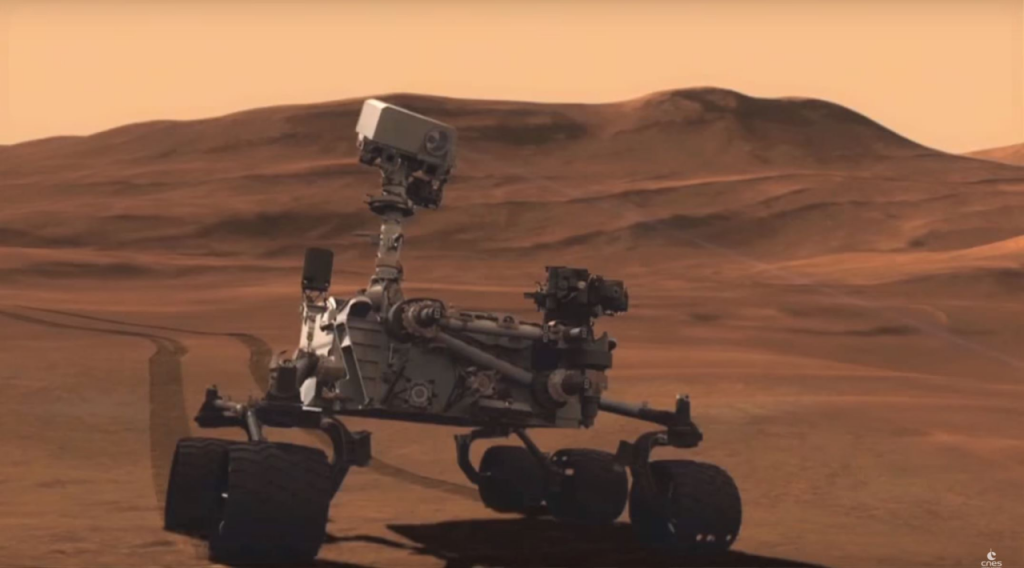PERSEVERANCE ROVER READY TO TAKE OFF TOWARDS MARS
On Tuesday 30 June 2020, Jean-Yves Le Gall, President of the CNES, and Antoine Petit, President and CEO of the CNRS, together presented the challenges of NASA’s “Mars 2020” mission, which will embark on the “Perseverance” rover, the Franco-American SuperCam instrument bound for the Red Planet. The launch by an Atlas V rocket from Cape Canaveral in Florida is scheduled between July 22 and August 11.

About four billion years ago, the Earth and Mars, much more similar than they are today, both had a dense atmosphere, liquid water, and a large-scale magnetic field. Hence the fundamental question that drives exobiologists: “If life developed on Earth at that time, could life have emerged on Mars as well?
Perseverance will explore ancient environments of the planet Mars in order to decipher its geological history and better characterize its past habitability. It will search for traces of ancient life by detecting possible biosignatures. Its mission is also to prepare for human exploration of Mars. The rover is also designed to collect samples that will be retrieved and brought back to Earth thanks to the joint missions of the United States and Europe planned for a sample return within the next ten years (MSR, Mars Sample Return).
Perseverance carries seven instruments and a sample collection and conditioning system. It will also place a small drone, Ingenuity, on the surface of Mars. The French contribution concerns the SuperCam instrument, an improved version of ChemCam which operates aboard NASA’s Curiosity rover.
SuperCam will study the chemistry and mineralogy of the rocks and soils of Mars, as well as the composition of its atmosphere. SuperCam is the “Swiss Army Knife” of the mission scientists. It performs five different types of analysis: one measurement of elemental chemical composition, two molecular measurements (the way atoms are bound together, and the arrangement of molecules within minerals), an imager to photograph the targets being analyzed, and a microphone. SuperCam carries many complex subsystems, including a power laser made in France. The instrument will help scientists in their search for early, fossilized signs of microbial life on the Red Planet.
In February 2021, Perseverance will be deposited in the Jezero crater, an impact basin 45 kilometers in diameter. This crater is home to an ancient river delta that flowed into a lake 3.5 billion years ago. The ancient lake-delta system offers the opportunity to collect samples from a wide variety of rocks and minerals, especially carbonates that can preserve fossil traces of ancient life.
For Jean-Yves Le Gall, President of CNES, “France’s return to Mars, aboard NASA’s Perseverance rover, is a new recognition of the excellence of the French scientific community in the study of the Red Planet. The work that Perseverance will undertake is in line with the discoveries made by previous Mars missions, it will teach us more and more about our history, our environment and the prospects for the future. Once again, I would like to thank all the participants in this beautiful and great mission, as well as NASA, which renews its confidence in us. Let’s meet again from July 22nd to live together a new page in the history of space exploration! »
For Antoine Petit, Chairman and CEO of the CNRS, “With Mars 2020, teams from the CNRS and its partners will be transported to the Martian terrain thanks to the ingenuity of NASA and CNES. Could life have appeared elsewhere than on Earth? This is the big question that our laboratories will be able to tackle through this mission. To this end, they have invented and built in record time the SuperCam tool that will be used to select the most promising samples on the basis of their atomic and molecular composition, those that will deserve to make the journey to Earth by 2030. Congratulations to all of you, the adventure has only just begun! »
NASA is relying on Caltech/JPL for the development of the Mars 2020 mission. SuperCam is jointly developed by Los Alamos National Laboratory (Los Alamos, USA) and a consortium of French laboratories under the scientific direction of IRAP (CNRS / CNES / University Toulouse III Paul Sabatier, in Toulouse, France), with a contribution from the University of Valladolid (Valladolid, Spain). CNES is responsible, towards NASA, for the French contribution to SuperCam. CNES, CNRS and many universities have provided human resources for the construction of this instrument. The French team contributing to SuperCam will participate daily in the scientific operations and the instrument will be operated alternately from the LANL and the control center installed at CNES in Toulouse (FOCSE Mars 2020).
In France, many laboratories, attached to CNRS and its partners, institutions have brought their scientific expertise and contributed to the construction of SuperCam: IRAP (Toulouse), LESIA (Meudon), LAB (Bordeaux), LATMOS (Guyancourt), OMP (Toulouse), IAS (Orsay) 1), ISAE-SUPAERO (Toulouse) and CNES.
Further Resources
- CNES Press Release
- CNRS-INSU Press Release
- Press Review :
- Une équipe toulousaine pour percer les mystères de la planète Mars (Le Journal Toulousain)
- La caméra laser Supercam est prête à décoller pour Mars (La Dépêche du Midi)
- SuperCam : un concentré technologique pour Mars 2020 (IT.com)
- Prochain retour de la France sur Mars (Cité de l’Espace)
- Où atterrira le rover Perseverance sur Mars ? (Futura Sciences)
- Comment la France va aider la NASA à chercher des traces de vie sur Mars (01.net)
- Le rover « Perseverance » s’en va collecter des bouts de Mars pour les ramener sur Terre (20 minutes)
- Events :
- Lundi 20 juillet 2020 : journée martienne à la Cité de l’Espace
- Suivez le lancement en direct : Mars 2020 : #CapSurMars ! (CNES)
IRAP Contact
- Sylvestre Maurice, sylvestre.maurice@irap.omp.eu






